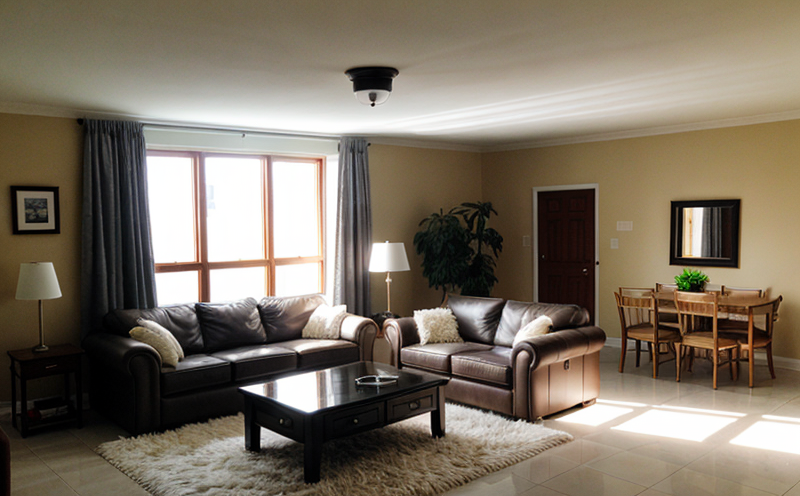ISO 8995 Indoor Lighting Ergonomic Testing for Visual Comfort
The ISO 8995 standard provides a comprehensive framework for testing indoor lighting systems to ensure they meet ergonomic requirements, specifically focusing on visual comfort. This test ensures that the lighting system does not cause discomfort or reduce productivity due to glare, brightness, contrast, and color rendering.
Visual comfort is crucial in workspaces where employees spend significant time performing tasks under artificial light. Poorly designed indoor lighting can lead to increased eye strain, headaches, and reduced efficiency, impacting both worker health and overall productivity. The ISO 8995 standard aims to prevent these issues by providing a standardized method for testing the visual comfort of indoor lighting systems.
The testing procedure involves multiple steps to evaluate different aspects of visual comfort:
- Light Intensity: Ensuring that light levels do not exceed or fall below recommended levels to avoid glare and eye strain.
- Glare Control: Assessing the amount of direct and indirect light that reaches a person's eyes, ensuring it is within acceptable limits for comfort.
- Critical Glare Angle: Determining if there are any angles from which glare could be harmful or uncomfortable to users.
- Color Rendering Index (CRI): Evaluating how well the lighting system renders colors of objects, ensuring that colors appear natural and true.
- Luminance Contrast: Checking the contrast between light and dark areas in the workspace to ensure it is within acceptable levels for comfort.
- Color Temperature: Ensuring the color temperature of the lighting does not cause discomfort or reduce efficiency.
The testing process involves measuring various parameters using specialized equipment, including photometers, illuminance meters, and glare meters. Specimens are typically representative samples of the lighting systems to be tested. The results are then analyzed against the criteria outlined in ISO 8995 to determine compliance with visual comfort requirements.
| Parameter | Description | Acceptance Criteria |
|---|---|---|
| Light Intensity | Measured using an illuminance meter in the workplace area. | Range of 300 to 1,500 lux for general office lighting. |
| Glare Control | Assessed by a glare meter in defined viewing zones. | Glare angle should not exceed 20 degrees from the vertical axis. |
| Critical Glare Angle | Determined using a critical glare angle test fixture. | The angle should be less than 15 degrees. |
| Color Rendering Index (CRI) | Evaluated using a spectrophotometer or colorimeter. | CRI value of at least 80 is required for good visual comfort. |
| Luminance Contrast | Metric derived from measurements taken with a luminance meter. | Contrast ratio should be between 2:1 and 4:1 in the workplace. |
| Color Temperature | Measured using an optical spectrometer or colorimeter. | The color temperature should fall within the range of 3,000 to 6,500 K for general office lighting. |
The ISO 8995 standard is widely recognized in industries that require high levels of visual comfort and productivity. Compliance with this standard ensures that indoor lighting systems are designed and installed to meet ergonomic requirements, leading to improved worker health and efficiency.
Customer Impact and Satisfaction
- Improved Productivity: Studies have shown that employees working in environments with well-designed lighting systems experience reduced eye strain and increased productivity.
- Enhanced Worker Well-being: Comfortable lighting conditions contribute to a positive work environment, reducing the risk of stress and fatigue.
- Better Quality Control: Ergonomic lighting can help in maintaining consistent quality by minimizing variations caused by poor light conditions.
Customer satisfaction is directly linked to the effectiveness of indoor lighting systems. By ensuring compliance with ISO 8995, organizations not only meet regulatory requirements but also enhance their reputation as providers of high-quality products and services.
Competitive Advantage and Market Impact
The implementation of ISO 8995 indoor lighting ergonomic testing can provide significant competitive advantages for companies in the lighting industry. By demonstrating a commitment to ergonomics and visual comfort, organizations can attract customers who prioritize worker well-being and productivity.
- Brand Reputation: Compliance with international standards enhances brand reputation and credibility.
- Innovation Leadership: Organizations that invest in ergonomic lighting solutions are seen as leaders in innovation within the industry.
- Market Differentiation: Offering products and services that meet or exceed international standards can differentiate a company from its competitors.
The market impact of ISO 8995 compliance is substantial. It sets a benchmark for quality and ergonomics, influencing not only the lighting industry but also other sectors that rely on indoor lighting systems for visual comfort.
Use Cases and Application Examples
- Offices: General office lighting should adhere to ISO 8995 standards to ensure employees have a comfortable working environment.
- Hospitals: Proper lighting in hospital settings can reduce the risk of errors and improve patient recovery times.
- Schools: Ensuring that classroom lighting meets ergonomic standards helps students learn more effectively.
- Manufacturing Plants: Ergonomic lighting in manufacturing plants can enhance worker efficiency and reduce accidents.
| Use Case | Description | Impact |
|---|---|---|
| Hospital Operating Rooms | Lighting should be optimized for the specific tasks performed in operating rooms to ensure precision and safety. | Reduces errors and improves patient recovery times. |
| School Libraries | Lighting should support visual comfort during extended reading sessions. | Enhances learning outcomes and student well-being. |
| Call Centers | Lighting should minimize eye strain for employees who spend long hours on the phone or using computers. | Increases call center efficiency and reduces employee turnover. |
These use cases demonstrate how ISO 8995 indoor lighting ergonomic testing can be applied across various sectors to ensure that lighting systems meet ergonomic requirements, leading to improved productivity and worker well-being.





